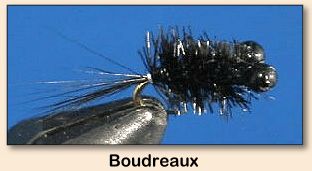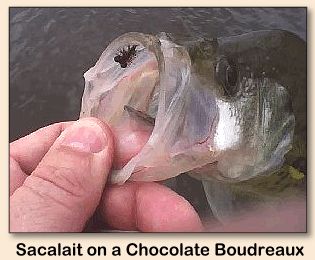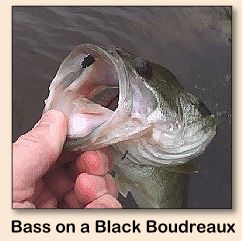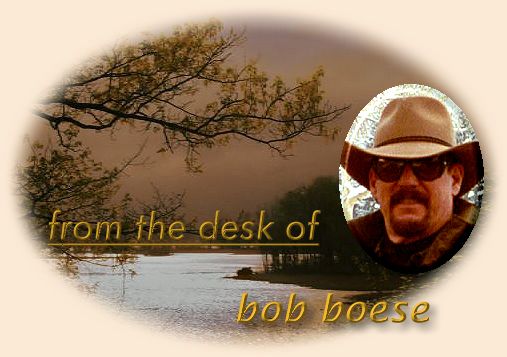|
Thibodeaux's wife bought a new book entitled What
Twenty Million American Women Want. Thibodeaux
saw the book's title, then grabbed the book out of her hand and
started thumbing quickly through the pages. Furious, his wife said,
"What in the world are you doing?"
Thibodeaux replied, "I just want to see if they've got my name
spelled right."
How often do you wonder about names of flies? Today, you have
to have a lot of chutzpah to name a fly after yourself. So, let's take
a second to look at some famous flies from the past and their fly tyer
creators.
Isacc Walton describes the Woolly Worm (in 1653) but Russel
Blessing of Harrisburg, Pennsylvania claims the Woolly Bugger
from a fly he created in 1967.
The John (Jock) Scott created in the 1850s by Jock Scott.
The hare's ear is attributed to James Ogden in the 1880s
The Adams fly was designed by Len Halladay of Michigan in 1922.
The Coachman was created by Tom Bosworth, who drove
the coach for Queen Victoria. Then came the Royal Coachman,
in 1878, by John Hailey, in New York city, followed by the Royal
Wulff created in 1930 by Lee Wulff.
The Dark Cahill was named after Dan Cahill in 1884.
The Grey Ghost was the creation of Maine's Carrie Stephens
at the turn of the 20th Century.
The Mickey Finn, Blue Dunn, Black Gnat, Bitch Creek
and Blue Wing Olive have unknown originators in the
American west.
The Humpy is credited to Jack Dennis of Jackson Hole,
Wyoming.
The Irresistible is attributed to Harry Darbee of New York
in the 1930s.
The Renegade was claimed by Taylor Williams of Sun
Valley in the 1930s.
The Klinkhammer is by Dutchman Hans Van Klinken.
The Muddler Minnow came from Dan Grapen
of Minnesota.
Winnie Morawski of Scotland produced a Tube Fly in 1945.
Griffiths Gnat was created George Griffith in the 50s.
The Pheasant Tail Nymph came from Frank Sawyer
of England in 1958.
The Zonker was invented by Dan Byford.
The Clouser comes from Bob Clouser.
The Deceiver comes from Lefty Kreh
The Stimulator was popularized (if not originated) by
Randall Kaufmann in the 70s.
Many soft hackle flies were created or recreated
by Sylvester Nemes in the mid 70s.
The Elk Hair Caddis was by Al Troth in 1978.
The foam diver is by Skip Morris from the 1990s.
The Boudreaux came from Ray Boudreaux after Y2K.
Okay, what was the purpose of that exercise? Note that names
of creators do not have to, and rarely do, accompany a fly. If your
living comes from fly fishing, you are going to stick your name on
anything that comes off of your vise and hope it adds to your cache.
Dan Bailey apparently insisted the Lee Wulff put his name on his flies,
and fame followed. For the rest of us, we will remain in obscurity like
the Winnie Morawskis of this world.
I took it upon myself to insist Ray Boudreaux to call his fly The
Black Boudreaux because I am addicted to its catch-everything
ability, because it sounds like a Louisiana fly should, and because
Ray couldn't think of a better name. Walking around various FFF
Conclaves with some of the best fly tyers in the South, I have no
hesitation is asking "What do you call that beautiful fly?" and the
usual answer is "some kind of bug." Curiously, this concept of
humility is completely foreign to on-line pattern posters. Take a
trip around Internet pattern sites and you will find perhaps the John
Doe Bad Ass Woolly Bugger, which looks like a thousand other
woolly buggers except this one has a color combination Doe once
saw on the ceiling of a disco (where three sheets John was lying on
the floor at the time). New fly tyers are particularly susceptible to
naming their creations, despite their less than stellar craftsmanship,
after themselves. Maybe the sloppier a fly the more it reflects its
maker.
True, there are times when a fly that looks like someone tied on a
hairball from Joe the Rag Picker's ratty cat it will outfish anything
else on the river. My daughter's pets shed (this is no lie) two vacuum
bags worth of hair a week. I have yet to develop the sled dog muddler
or the orange tabby prince, but some day. Chances are, if they are
unique, I may name them after Ozzie and Yogi (my daughter is a
baseball fan), but more likely they'd end up the wet dog wiggler or
feral floater.

Meanwhile, I will take responsibility for naming the Boudreaux.
There was a point in time when someone said to someone else:
"Why the hell didn't you tell me about sliced bread?" Now let
us suppose that the someone else had been showing up every
day with a sliced bread sandwich and was chowing down on
his version of a BLT when everyone else was ripping and tearing
off hunks from a baguette. You might think maybe, just maybe,
someone should have noticed.
Since it's creation, I have been singing the praises of the Black
Boudreaux (which is sometimes chocolate, or olive or tan.)
Perhaps if it was a secret, fly fishers would pay more attention.
Boudreaux's cousin Chauvin and the miller's daughter, Angelle
were to be married. As the big day approached, the bride and
groom grew apprehensive. Each had a secret problem they had
never before shared with anyone. So…Chauvin asked
Boudreaux for advice. "Boudreaux," he said, "I am deeply
concerned about the success of my marriage. Angelle is so
delicate and I have very smelly feet, and I'm afraid that she
will be repelled by them."
"No problem," said Boudreaux, "all you have to do is wash
your feet regularly, and always wear socks, even to bed."
Chauvin thought this seemed like a workable solution.
At the same time, the bride-to-be, explained her problem to,
Madeline, her maid of honor.
"Madeline," she said, "When I wake up in the morning my breath
is truly awful."
"Girl friend," Madelin consoled, "everyone has bad breath in the morning."
"No, you don't understand. My morning breath is so bad, I'm
afraid that Chauvin will not want to sleep in the same room with
me."
Madeline said simply, "Try this. In the morning, get straight out of
bed, and head for the bathroom and brush your tongue where bad
breath grows. The key is, don't say a word until you've brushed.
Not a word." And … Angelle thought it was certainly worth
a try.
The couple were married and each one remembered the advice
they had received, Chauvin with his perpetual socks and Angelle
with her morning silence. They managed quite well…until
about six months later.
Shortly before dawn, Chauvin woke with a start to find that one
of his socks had come off. Fearful of the consequences, he
frantically searched the bed.
This woke Angelle who, without thinking, immediately asked,
"What on earth are you doing?"
"Oh, no!" Chauvin gasped, "You've swallowed my sock!"
Fly fishing secrets are too good to keep. The problem is,
shared secrets are too often misunderstood or simply ignored.
Such a secret is the Black Boudreaux. At the risk of sounding
like a broken record, I again proclaim the excellence of this
simple and incredibly effective fly that most of my readers ignore.
Take August, for example. Following several hours of torrential
downpour from Hurricane Ike, the lake behind my house rose
about six inches. Fresh water poured in from several French
drains leading to the lake. Fish could be seen actively feeding
along the shoreline and soon many large bluegill and small bass
fell prey to a chocolate Boudreaux. A large swirl attracted a cast
and the popper from which the Boudreaux dangled disappeared
in a blur. A hard hook set preceded a full ten minutes of fight as
the soft 7'-3wt. struggled to handle the leaping, pulling, twisting
four pound bass. When the big predator was worn down,
examination revealed the chocolate Boudreaux firmly impaled
about an inch back in the top of his mouth. Unfortunately, no
camera was handy, but a few more fish followed, none that size,
although a pair of 9" bluegill were worthy foes.
 The outing ended as a large something-or-the-other broke
the 6# tippet and left with the Boudreaux. Two weeks earlier
green sunfish battled each other in a Florida pond for a change
to eat a grey Boudreaux and a week before that Houston bass
and sunfish attacked the black Boudreaux furiously. In July,
Colorado rainbows and browns took the fly. Some fly!
The outing ended as a large something-or-the-other broke
the 6# tippet and left with the Boudreaux. Two weeks earlier
green sunfish battled each other in a Florida pond for a change
to eat a grey Boudreaux and a week before that Houston bass
and sunfish attacked the black Boudreaux furiously. In July,
Colorado rainbows and browns took the fly. Some fly!
The Black Boudreaux
created by Ray Boudreaux (Acadiana Fly Rodders)
Hours of fishing lakes and ponds have proven that no new pattern
is more effective overall than the Black Boudreaux. Using this
pattern, practically all local warmwater species have been caught,
including panfish, bass, sacalait, shad, gar, catfish and choupique
(not a fun time for fly equipment there). The fly is easy to tie and
is fished either alone or as a dropper. It is a small fly (size 14) and
barbeless hooks are highly recommended. Size and color are
important, and while black has proven to be the best, olive and
chocolate (see sacalait photo) work as well. This recipe deviates
slightly from the original, but the manner of tying the fly shown below
is intended to accurately reflect Ray's pattern concept and create a
durable fly that will withstand many fish. A fly with a tinsel underbody
works better than without and super glue the hackle to the tinsel or it
can unravel after a few fish. A drop of fish attractant or WD40
disguises the scent of glues.
Hook: Size 14 scud hook (Dai-Riki #135, Eagle
Claw L055, Mustad C49S, Tiemco 2457, Cabelas Model 25,
or similar)
Thread: Flat waxed nylon.
Eyes: Small black bead chain.
Tail: 6-10 hackle barbs.
Hackle: Dry fly saddle hackle.
Underbody: Tinsel over thread.
1. Wrap the hook shank from the eye to the start of the
bend with thread. Using a scud hook produces a better
shaped (curved) fly and provides more hookups. Most
scud hooks are slightly offset, which is acceptable. Flat
waxed nylon thread is used for durability.
 2. Tie in the tail at the beginning of the hook bend with about
¼"-3/8" extending past the hook. Biot or maribou can
also be used, but simple hackle barbs work best. Bring the
thread forward to the hook eye.
2. Tie in the tail at the beginning of the hook bend with about
¼"-3/8" extending past the hook. Biot or maribou can
also be used, but simple hackle barbs work best. Bring the
thread forward to the hook eye.
3. Tie on the eyes immediately behind the hook eye with a
figure eight wrap and put on a tiny drop of super glue on the
wraps. (Small black bead chain is available from Hobby
Lobby.) Bring the thread back to the start of the tail.
4. Tie in stiff dry fly saddle hackle (with the shortest barbs
possible).
5. Tie in a strand of tinsel and bring the thread forward to
the eyes. Wrap the tinsel to completely cover the thread
on the hook shank and tie off behind the eyes.
6. Put a very light layer of super glue on top of the tinsel.
7. Tightly palmer the hackle up to the hook eye. Tie down
and clip the excess.
8. Whip finish around the eyes.
9. Trim the hackle barbs all around the shank to a length of about 1/8".
10. Put a small drop of Hard as Nails on the whip finish between
the eyes. ~ Bob
About Bob:
Robert Lamar Boese has fly fished for five decades. He is an
environmental negotiator, attorney and educator who has provided
environmental legal services for more than thirty-three years including
active duty with the U.S. Coast Guard and Department of Justice. He is a
well known fly tyer with several unique patterns to his credit. He has
developed and authored federal and state regulatory programs
encompassing a broad spectrum of environmental disciplines, has
litigated environmental matters at all levels of the federal and state
court systems, and is a qualified expert for testimony in environmental
law. He has authored over 60 published text chapters, comments or
articles on environmental matters, is a member of the Colorado, District
of Columbia and Louisiana Bar Associations, and is a certified mediator.
In addition to his legal practice, Mr. Boese has been a high school
teacher, an associate professor of Environmental Law and Public Health,
has authored numerous fiction and sports publications, and is a softball
coach and nationally certified volleyball referee. He is the president
of the Acadiana Fly Rodders in Lafayette, Louisiana and editor of
Acadiana on the Fly. He has been married for thirty years and is the
father of two fly fishing girls (25 and 21). For additional information
contact: Boese Environmental Law, 103 Riviera Court, Broussard, LA 70518
or call 337.856.7890 or email coachbob@ymail.com.
|





